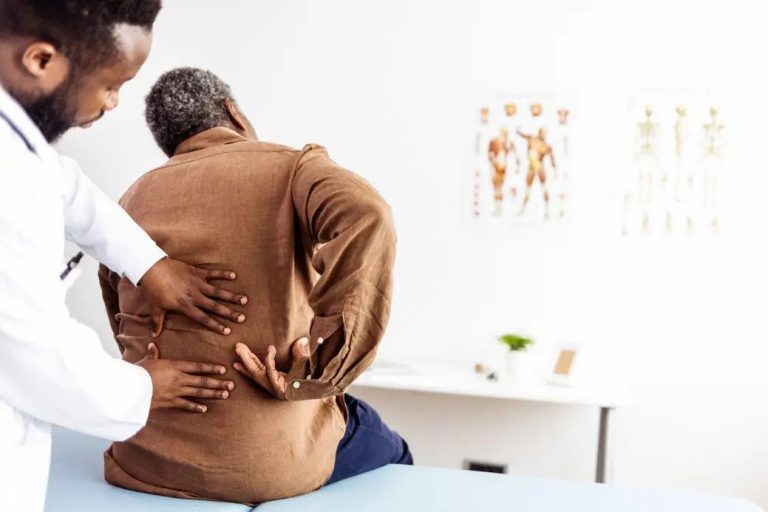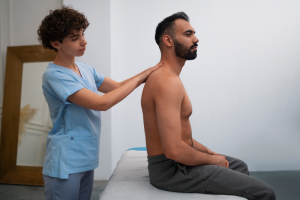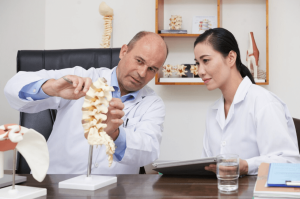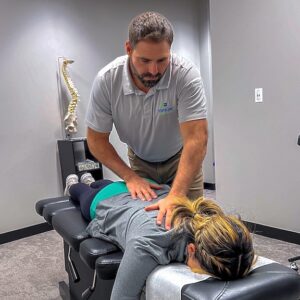Lower back pain is a widespread issue affecting people of all ages and lifestyles. It can range from a dull, nagging discomfort to severe, debilitating pain, impacting one’s ability to perform daily activities. Chiropractic care has gained recognition as an effective treatment for lower back pain, offering a non-invasive and drug-free approach to managing this common ailment. In this article, we will explore the causes, symptoms, and potential chiropractic solutions for lower back pain, shedding light on how chiropractic services can aid in finding relief.
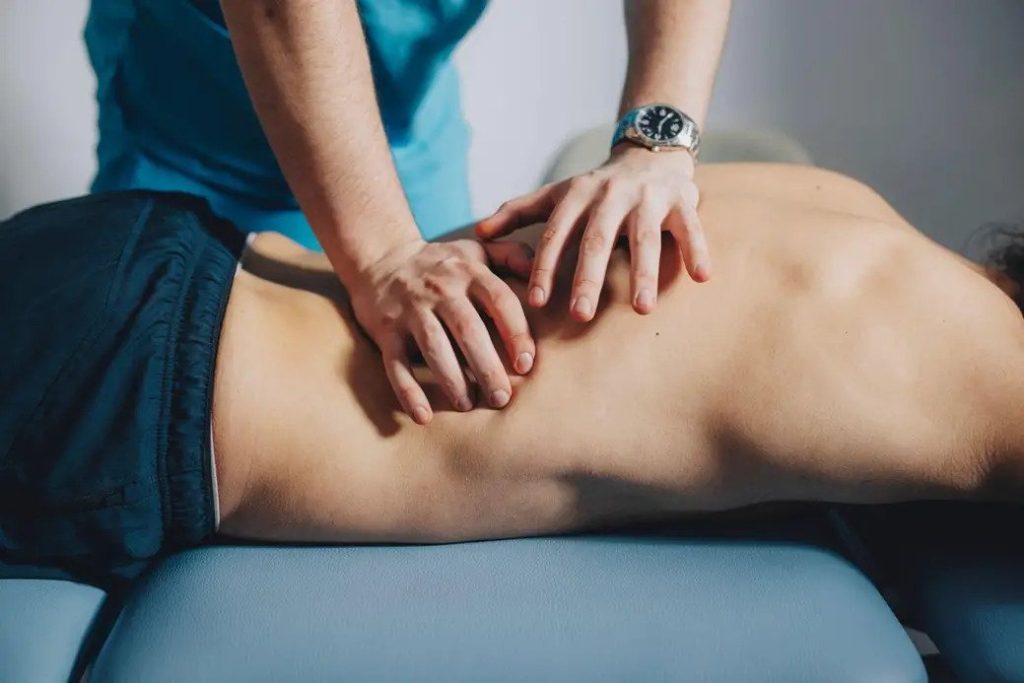
Understanding Lower Back Pain
The lower back, or lumbar region, consists of the five vertebrae (L1 to L5) in the spine. It plays a crucial role in supporting the upper body, facilitating movement, and protecting the spinal cord. However, the lower back is prone to pain and discomfort due to various factors.
Causes of Lower Back Pain
1. Muscle Strain and Ligament Sprain
Muscle strain and ligament sprain, collectively known as soft tissue injuries, are prevalent causes of lower back pain. These injuries occur when the muscles or ligaments in the lower back are subjected to sudden or excessive stress, often due to improper lifting techniques, abrupt movements, or overuse during physical activities. The stress or trauma can lead to microscopic tears in the muscle fibers or ligaments, causing pain, stiffness, and muscle spasms.
Muscle strains typically involve the stretching or tearing of muscle fibers, whereas ligament sprains involve damage to the tough, fibrous bands that connect bones to other bones (ligaments). The lower back’s musculature and ligamentous structure play a crucial role in supporting the spine and facilitating various movements. When these tissues are injured, they can cause localized lower back pain and discomfort, making everyday activities challenging.
2. Herniated Disc (Disc Herniation)
Intervertebral discs are flexible, rubbery cushions between the vertebrae in the spine, providing support, flexibility, and shock absorption. A herniated disc, also known as a ruptured or slipped disc, occurs when the soft inner core (nucleus pulposus) of a disc protrudes through a tear or rupture in the tough outer layer (annulus fibrosus). This protrusion can press against nearby spinal nerves, leading to symptoms such as pain, numbness, or weakness in the lower back and down one or both legs.
The pressure on the nerves caused by a herniated disc can result in radiating pain, known as radiculopathy or sciatica. Depending on the location of the affected disc, individuals may experience symptoms along the path of the compressed nerve, which can include shooting pain, tingling, and muscle weakness. The intensity of symptoms can vary based on the degree of disc herniation and the nerve’s sensitivity to compression.
3. Spinal Stenosis
Spinal stenosis refers to the narrowing of the spinal canal, the central hollow space within the spinal column that encases the spinal cord and nerve roots. This narrowing can occur gradually over time due to various factors, including age-related changes, bone spurs (osteophytes), herniated discs, thickened ligaments, or congenital conditions. As the spinal canal narrows, it exerts pressure on the spinal cord and nerve roots, causing lower back pain and potentially radiating pain into the legs.
The symptoms of spinal stenosis can manifest as localized lower back pain, leg pain, numbness, or muscle weakness. The severity of symptoms often worsens with prolonged standing or walking and may be alleviated by sitting down or leaning forward. Understanding the underlying cause of spinal stenosis and its impact on nerve compression is crucial for appropriate treatment and management.
4. Osteoarthritis
Osteoarthritis, commonly known as degenerative joint disease or wear-and-tear arthritis, is a chronic condition that affects the joints and cartilage within the spine. Over time, the cartilage, which acts as a cushion between the vertebrae, gradually wears away, leading to increased friction and bone-on-bone contact. This degeneration can cause inflammation, pain, stiffness, and reduced mobility in the lower back.
The body’s attempt to repair the damaged cartilage may result in the formation of bone spurs (osteophytes) around the edges of the affected joints. These spurs can further contribute to pain and discomfort by impinging on nerves or restricting movement. Osteoarthritis-related lower back pain is often exacerbated by activities that put stress on the spine, such as lifting heavy objects or prolonged periods of standing or sitting.
5. Spondylolisthesis
Spondylolisthesis is a condition characterized by the forward or backward slippage of one vertebra in the spine over an adjacent vertebra. This misalignment can occur due to various factors, including a defect or stress fracture in the bony arch of the vertebra (pars interarticularis). Common causes of spondylolisthesis include repetitive stress on the spine, congenital abnormalities, trauma, or degenerative changes.
When a vertebra slips out of position, it can compress spinal nerves, leading to lower back pain and muscle tightness. The severity of symptoms and degree of slippage can vary, influencing the type of treatment required to alleviate discomfort and stabilize the affected vertebrae.
6. Sciatica
Sciatica is a specific type of lower back pain resulting from compression or irritation of the sciatic nerve, the largest nerve in the body. The sciatic nerve originates from the lower back (lumbar region) and travels down each leg. Irritation of this nerve can stem from various sources, such as a herniated disc, bone spur, spinal stenosis, or spondylolisthesis.
When the sciatic nerve is compressed or pinched, it can cause intense, shooting pain that radiates from the lower back through the buttocks and down the leg (commonly one leg). In addition to pain, individuals may experience numbness, tingling, and muscle weakness along the path of the affected nerve.
Symptoms of Lower Back Pain
1. Localized Pain:
Localized pain is the hallmark symptom of lower back pain. It typically manifests as aching, dull, or sharp pain in the lower back region, ranging from the base of the spine (sacrum) to the area just below the ribcage. The pain can be constant or intermittent and is often exacerbated by movement or specific positions, such as bending, lifting, or prolonged sitting or standing.
2. Radiating Pain:
Lower back pain can extend beyond the lower back itself and radiate into other areas. This is often described as shooting pain or a sensation of burning or tingling that travels from the lower back down the buttocks and may extend further into the back of the thigh, calf, or even the foot. This radiating pain is commonly associated with conditions like sciatica, where the sciatic nerve, originating in the lower back, is compressed or irritated.
3. Stiffness and Reduced Mobility:
Individuals with lower back pain often experience stiffness in the lower back muscles and surrounding areas. This stiffness can lead to reduced flexibility and limited range of motion, making it difficult to bend, twist, or perform everyday activities. Morning stiffness is a common complaint and tends to improve as the day progresses and the muscles loosen up.
4. Muscle Spasms:
Muscle spasms are involuntary muscle contractions that can be painful and uncomfortable. In the case of lower back pain, the muscles in the affected area may contract or spasm, causing a sudden, intense, and sometimes debilitating pain. These spasms often occur as the body’s response to an underlying issue, attempting to stabilize the spine or protect the affected area.
5. Numbness or Weakness:
Lower back pain may be accompanied by sensations of numbness, tingling, or weakness in the legs or feet. This is indicative of nerve involvement or compression, such as in the case of a herniated disc or spinal stenosis. Numbness and weakness may affect specific areas or extend along a nerve pathway, potentially impacting mobility and strength in the lower extremities.
Chiropractic Approach to Lower Back Pain
Chiropractic care focuses on diagnosing and treating musculoskeletal disorders, particularly those related to the spine. Chiropractors, healthcare professionals trained in chiropractic medicine, employ various techniques and approaches to help alleviate lower back pain and enhance overall spinal health.
Chiropractic Adjustments
One of the primary techniques utilized by chiropractors is spinal adjustments, also known as spinal manipulation. These adjustments involve applying controlled force to specific vertebrae to restore proper alignment and mobility in the spine. Adjustments can help alleviate pain, reduce inflammation, and enhance the body’s ability to heal naturally.
At Evolve Chiropractic in Woodstock, Illinois, experienced chiropractors utilize precise adjustments to target the affected areas of the lower back, tailoring the treatment to each individual’s unique needs.
Soft Tissue Therapy
Chiropractors may employ soft tissue techniques to complement adjustments. These therapies focus on relaxing and releasing tension in the muscles, tendons, and ligaments surrounding the spine. Massage, myofascial release, and trigger point therapy are common soft tissue approaches that can aid in reducing muscle spasms and improving flexibility.
Exercise and Rehabilitation
Chiropractors often incorporate customized exercise programs and rehabilitation techniques to enhance strength, flexibility, and posture. These exercises target specific muscle groups and aim to improve the stability of the spine, ultimately assisting in the prevention and management of lower back pain.
In addition to these primary chiropractic approaches, lifestyle modifications, and ergonomic advice may also be provided to patients. Simple changes in daily habits, such as proper posture while sitting or lifting, can make a significant difference in preventing or managing lower back pain.
Stay tuned for the continuation of this informative blog, where we will delve deeper into chiropractic treatment plans, patient testimonials, and how you can take proactive steps toward a pain-free lower back with chiropractic care.
Why Choose Us?
Evolve Chiropractic of Vernon Hills is a leading chiropractic clinic in the Vernon Hills area, dedicated to providing top-tier chiropractic care and wellness services. With a team of experienced and highly skilled chiropractors, we are committed to helping our patients achieve optimal health and well-being.
Our mission at Evolve Chiropractic is to offer personalized and effective chiropractic treatments to address a wide range of musculoskeletal issues, including back pain, neck pain, headaches, and more. We believe in a holistic approach to healthcare, focusing on the root causes of discomfort and pain, and working with our patients to improve their overall quality of life.
What sets us apart is our dedication to staying at the forefront of chiropractic advancements and techniques. We utilize state-of-the-art equipment and evidence-based practices to ensure that our patients receive the highest standard of care. Our friendly and professional team is here to provide a welcoming and supportive environment for every individual who walks through our doors.
At Evolve Chiropractic of Vernon Hills, we are committed to being the best Chiropractor Vernon Hills in the area, and we look forward to helping you on your journey to improved health and wellness.
Evolve Chiropractic of Vernon Hills
750 Bunker Ct Ste 700, Vernon Hills, IL 60061, United States
224-424-4938
https://myevolvechiropractor.com/locations/chiropractor-in-vernon-hills-il

